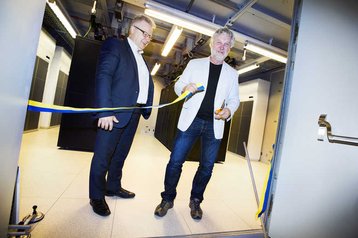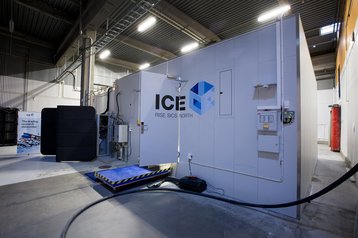Two years ago, Sweden was placed top in the European Innovation Scoreboard by the EU Commission. This vindicated years of educational policy, and reflected a national willingness, both public and private, to invest in research and innovation, and create partnerships joining academia and enterprise to drive the country’s economy forward.
Sweden also harbors the perfect conditions for building the energy-greedy, monolithic structures that process the reams of data that keep the world’s digital wheels turning.
Welcome to the Node Pole
Thus, it is unsurprising that a publicly funded Swedish research institute in Luleå – both an industrial and an academic hub, the location of two of Facebook’s hyperscale facilities and the second biggest contributor to the country’s GDP – is combining these two fields of expertise, having launched a fully functioning data center devoted entirely to research and development of new cloud and infrastructure technologies.
RISE SICS North, a subsidiary of applied information and communication technology research institute, was launched specifically to allow Europe’s academic institutions and businesses to take on data center related projects in a simulated environment.
The institute’s data center, the SICS Infrastructure and Cloud Research & Test environment (ICE), was built as a sort of innovation incubator, to boost European capability within the data center industry.
The initiative is based on the premise that the world is set to enter a new era, with compute power in huge demand. To enable this, the data center industry must build on existing knowledge to develop elaborate, software-controlled IoT systems, capable of operating autonomously while leveraging machine learning to its full potential.
The head of research for Ericsson, Tor Björn Minde, is the project’s CEO. He told us that ICE was launched to attract companies and projects to the Node Pole region around Luleå. “This will enable a sustainable competence development,” he said. “New innovations and skilled people are needed to develop the Swedish economy.”
Up from only three staff members in January last year, the facility now operates with twelve people, he said, “and we have a €2.3 million ($2.84m) annual turnaround.”
Funding comes from all directions: “From companies - Vattenfall, ABB, Ericsson, Facebook. We get regional and national subsidies, and we have one EU project at the moment as well.”
A playground for the industry
When Minde gave us a virtual tour of his facility, he proudly showed off the DCD Award for Best Data Center Initiative of the Year that the institute received at the ceremony held in December last year. “I bought the cabinet in September and had only one award to put in it. Everybody laughed. Nobody is laughing anymore.”
The 600 square meter facility is a gift that just keeps giving; all manner of experiments and novel equipment fill the room, such as a liquid cooling tank designed and built in-house, a miniature network operations center to test out DCIM systems, and an ABB microgrid controller.
The research data center’s first room-in-room module came online in February 2016, based on Dell SmartEdge Rx730xd servers with GPU acceleration and both OpenStack and Hadoop storage.
Then in May 2017, a second, more flexible “lab-like” module was launched, with more power and faster networking connections than its predecessor, and this time equipped with a combination of Dell and OCP v2 servers, standing on raised floors and partitioned using industrial PVC curtains. The latter, Minde tells us, like everything else in there, is something they are testing out. Another setup, more experimental still, will be an OCP lab, fitted with edge PDUs; though for now, only a switchboard has been installed.
Another object of study was brought to the lab by Jon Summers, a senior lecturer at the UK’s University of Leeds, also RISE SICS North’s scientific leader and an expert in CFD and energy efficient cooling systems: a glass box the size of a room, designed by DigiPlex, which is in fact a small, contained wind tunnel for airflow experiments.
Researchers are also exploring the possibility of using chimneys to create drafts powerful enough to action fans in HVAC systems, in the form of four retrofitted 19-inch racks containing OCP servers, placed in a cross to allow for a chimney in the center.
Soon, Minde tells us, the site will have its own solar panels, a thermal storage bank and a heat pump for waste heat reuse.
Throughout the facility, networking operations are monitored by Zabbix 3.0 open source software, and additional sensors have been placed on PDUs, power switches, servers, network switches, UPS systems, coolers, power meters, thermometers and corrosion sensors, collecting between nine and ten gigabytes a day from 30,000 measurement points per module. The data is then fed to a Hadoop cluster using Apache Kafka processing software.
Projects currently underway seek to improve knowledge in the fields of data center automation, air-flow technologies, “industrial symbiosis,” as Minde calls it, or micro-grid integration, data collection and monitoring, and machine learning for the data center.
The study of “Artificial Intelligence for Datacenter Microgrid Interaction,” funded by the Swedish Energy Research Centre, looks at the possible applications, as well as the pros and cons, of integrating AI into a single controllable entity that would link a microgrid with a data center, in view of making it possible to take temperature, solar radiation, electricity cost and workload forecasts into account when operating an edge module.
“DC2BD” is a heat reuse project backed by Forest Developing Technologies and Future Eco, which is exploring the possibilities of using heat from data centers to dry biomass.
More widely, it seeks to demonstrate that creating a circular economy, where a data center would help create bio-coal or biofuel, and generate heat as part of a district heating system, for instance, is possible.
The facility is also the basis for a data analytics project called D-ICE, a platform that enables data owners and data scientists to share information - the former gaining from in-depth analysis of their data using new tools, and the latter obtaining access to the reams of information necessary to test out new methods.
The 60 plus companies participating in projects (although, Minde tells us, approximately 40 are actively involved) are continuously invited to see the research institute and improve their own efficiency and sustainability practices, while contributing to the wider European market.
Cyclic innovation
For Minde, innovation goes in cycles, from the bottom, through the hardware stack, up the software layers, in alternating phases.
Explaining the purpose of the institute last year, he said: “We [at RISE SICS North] improve on the foundation stuff; maybe now we’re going into a new hardware cycle; we have a lot of new innovations in the hardware side, there’s a lot of interest in the new types of hardware, and then the software will innovate on top of that. We at SICS are an integral part of that development.”
As for the future plans, he tells us, “in the next two to three years, we hope to double the [institute’s] activities and build a new facility that is two to three times larger,” making it between 2,500 and 3,000 square meters - a much bigger space in which to test out the technologies of tomorrow.
This article appeared in the February/March issue of DCD Magazine. Subscribe to the digital and print editions here:



